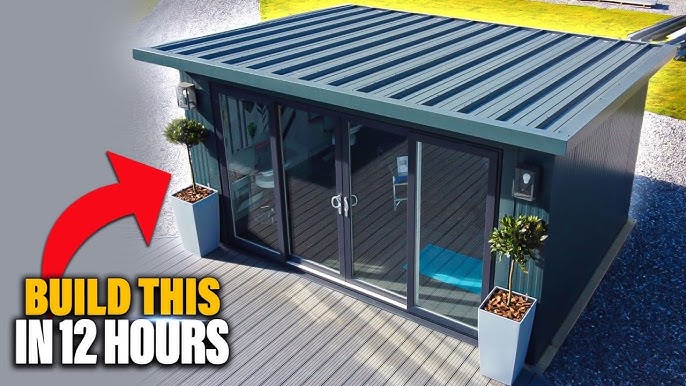Discover whether a garden room kit could save you thousands while still delivering your dream outdoor space – we reveal the crucial facts you need to know before making your decision.
Understanding Garden Room Kits: The Basics
Garden room kits represent a revolutionary approach to creating additional living space in your garden. These pre-fabricated structures typically arrive as flat-packed components, engineered for straightforward assembly. At their core, most garden room kits utilize Structural Insulated Panels (SIPs), which combine insulation and structural elements into single, efficient components. Modern kits can typically be assembled in 1-3 days by two people, offering a significant time advantage over traditional builds.
A standard garden room kit package usually includes:
- Pre-cut SIPs panels for walls, floor, and roof
- External cladding materials
- Door and window units
- Internal wall finishes
- Fixings and fasteners
- Detailed assembly instructions
- Technical support during installation
The Appeal of Garden Room Kits
The rising popularity of garden rooms stems from several compelling advantages. Research shows that homeowners can save between 20-35% compared to custom builds, making them an increasingly attractive option. The standardized manufacturing process ensures consistent quality, while pre-cut components eliminate waste and reduce construction time dramatically.
- Cost-effective solution with transparent pricing
- Quick assembly timeframes (typically 1-3 days)
- Reduced labour costs through DIY installation
- Minimal disruption to your property
- Standardized quality control in factory conditions
- Lower carbon footprint due to efficient manufacturing
Custom Garden Room Builds: The Traditional Approach
Bespoke garden rooms offer unparalleled flexibility in design and specification. These traditionally constructed buildings are built from scratch on-site by professional teams, allowing for complete customization of every aspect. While this approach typically costs more and takes longer, it provides the opportunity to create truly unique spaces that perfectly match your property and requirements.
Key benefits of custom builds include:
- Complete design freedom
- Ability to accommodate irregular spaces or slopes
- Professional installation included
- Extensive material and finish options
- Tailored solutions for complex requirements
Cost Comparison: Kits vs Custom Builds
Understanding the financial implications of both options is crucial for making an informed decision. Current market analysis shows that garden room kits typically range from £8,000 to £25,000, while custom builds can range from £15,000 to £50,000 or more. However, these figures can vary significantly based on size, specification, and location.
Cost breakdown for typical 4x3m garden room:
- Kit solution: £12,000-£15,000 (including DIY installation)
- Custom build: £18,000-£25,000 (professionally installed)
- Additional costs to consider for kits:
- Foundation work (if not included): £1,000-£2,000
- Electrical installation: £500-£1,500
- Professional assembly (if required): £2,000-£3,000
Installation and Assembly Considerations
The installation process differs significantly between kits and custom builds. Kit assembly typically requires basic DIY skills and usually takes 2-3 people working 1-3 days. Most manufacturers provide comprehensive instructions and technical support. Custom builds, conversely, are handled entirely by professional teams over 2-3 weeks.
Key installation factors for kits:
- Foundation preparation requirements
- Tool requirements and skill levels needed
- Access considerations for delivery
- Electrical and plumbing connections
- Local building regulations compliance
Quality and Performance Analysis
Both approaches can deliver excellent quality and performance when properly executed. Kit buildings using SIPs panels often achieve superior thermal efficiency, with U-values as low as 0.18 W/m²K. Custom builds can match or exceed these specifications but may require more complex construction methods.
Performance comparison:
- Thermal efficiency: Both options can achieve excellent results
- Durability: 25+ years expected lifespan for both
- Weather resistance: Comparable performance
- Sound insulation: Custom builds can offer superior options
- Fire safety: Both meet building regulations when properly specified
Making Your Decision: Key Factors to Consider
Your choice between a kit or custom build should be based on several crucial factors:
- Budget constraints and available funds
- Timeline requirements
- DIY skills and availability
- Specific use requirements
- Site conditions and access
- Local planning restrictions
- Long-term property plans
Conclusion: Which Option Is Right For You?
Both garden room kits and custom builds offer viable paths to creating additional living space. Kits present an excellent option for those with budget constraints and basic DIY skills, offering potential savings of 20-35% and quick installation. Custom builds remain the premium choice for those seeking unique designs or requiring specific features not available in kit form. Consider your priorities carefully – if cost and speed are paramount, a quality kit from established manufacturers like Pent Haus or Future SIPS could be ideal. However, if unique design and professional installation are more important, a custom build might better serve your needs. Remember to factor in all costs, including foundations and electrical work, when making your final decision.
FAQ
Do garden rooms need a concrete base?
While a concrete base offers stability and durability, it might not always be necessary. Concrete bases are not the greenest of choices and are a more expensive choice. Other options include concrete piles, ground screws and concrete pads.
Are plastic shed bases any good?
The benefits of choosing a plastic base are numerous. Not only is a plastic gravel base lightweight and cost-effective, but it also offers superior drainage efficiency, ensuring that your shed remains dry and damage-free.
What is the cheapest base for a garden room?
A concrete base is the most permanent and durable base for a garden building but a paving slab base is cheaper and more popular.
Is it cheaper to buy or build a garden bed?
DIY can be cheaper, but they can also be more time-consuming. You must account for the labor, tools, hardware, and maintenance of the beds. As a gardener who has had dozens of raised beds over the years, my plants perform equally well in my homemade and store-bought beds.
Sources
[1] https://www.futuresips.co.uk/product/diy-garden-room-kits/
[2] https://www.thegardenroomguide.co.uk/2024-guide-to-diy-garden-room-kits/2024/03/22/
[3] https://www.youtube.com/watch?v=5vbSlKwOxww


